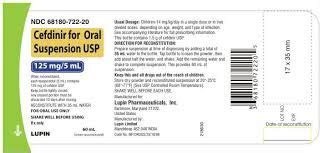Intro
Discover the potential risks of Cefdinir, a widely used antibiotic. Learn about common Cefdinir side effects, including allergic reactions, gastrointestinal issues, and central nervous system problems. Understand the medications interactions and contraindications to ensure safe usage. Get informed about Cefdinirs adverse effects and minimize the risk of complications.
Cefdinir is a popular antibiotic used to treat a variety of bacterial infections, including pneumonia, bronchitis, and skin infections. While generally considered safe, cefdinir can cause a range of side effects, some of which can be serious. In this article, we'll delve into the common and rare side effects of cefdinir, as well as what you can do to minimize your risk.

Cefdinir belongs to a class of antibiotics known as cephalosporins, which work by inhibiting the growth of bacteria. While effective against many types of bacterial infections, cefdinir can cause a range of side effects, from mild to severe.
Common Side Effects of Cefdinir
Some of the most common side effects of cefdinir include:
- Diarrhea
- Nausea and vomiting
- Abdominal pain
- Headache
- Dizziness
- Fatigue
- Rash
These side effects are usually mild and temporary, and may resolve on their own once you stop taking the medication. However, if you experience any of these symptoms, it's essential to talk to your doctor or pharmacist to determine the best course of action.

Rare but Serious Side Effects of Cefdinir
While rare, cefdinir can cause some serious side effects, including:
- Allergic reactions: Some people may be allergic to cefdinir, which can cause symptoms such as hives, itching, and difficulty breathing.
- Stevens-Johnson syndrome: This is a rare but life-threatening condition that can cause skin and mucous membrane lesions.
- Toxic epidermal necrolysis: This is a severe skin condition that can cause widespread skin lesions and blistering.
- Clostridioides difficile (C. diff) infection: Cefdinir can disrupt the balance of gut bacteria, leading to a C. diff infection.
- Seizures: Cefdinir can cause seizures in rare cases, especially in people with a history of seizure disorders.
If you experience any of these symptoms, seek medical attention immediately.

Minimizing Your Risk of Cefdinir Side Effects
While side effects can occur, there are steps you can take to minimize your risk:
- Take cefdinir exactly as directed by your doctor or pharmacist.
- Complete the full course of treatment, even if you start to feel better.
- Inform your doctor or pharmacist about any allergies or sensitivities you have.
- Tell your doctor or pharmacist about any medications you're taking, including over-the-counter medications and supplements.
- Monitor your side effects and report any concerns to your doctor or pharmacist.
Cefdinir Interactions
Cefdinir can interact with certain medications, including:
- Antacids: Antacids can reduce the absorption of cefdinir.
- Proton pump inhibitors: PPIs can reduce the absorption of cefdinir.
- Warfarin: Cefdinir can increase the risk of bleeding when taken with warfarin.
Inform your doctor or pharmacist about any medications you're taking to minimize the risk of interactions.

Cefdinir and Pregnancy
Cefdinir is generally considered safe to use during pregnancy, but it's essential to talk to your doctor or pharmacist before taking the medication. Cefdinir can pass into breast milk, so it's recommended to use caution when breastfeeding.

Cefdinir Overdose
Taking too much cefdinir can cause serious side effects, including seizures and allergic reactions. If you suspect an overdose, seek medical attention immediately.

Conclusion
Cefdinir is a commonly used antibiotic that can cause a range of side effects, from mild to severe. While rare, serious side effects can occur, and it's essential to be aware of the risks and take steps to minimize them. By following the guidelines outlined in this article, you can reduce your risk of side effects and ensure a safe and effective treatment.

We hope this article has provided you with valuable information about cefdinir side effects. If you have any questions or concerns, please don't hesitate to reach out to your doctor or pharmacist. Share this article with your friends and family to help them make informed decisions about their healthcare.
What is cefdinir used for?
+Cefdinir is used to treat a variety of bacterial infections, including pneumonia, bronchitis, and skin infections.
What are the common side effects of cefdinir?
+Common side effects of cefdinir include diarrhea, nausea and vomiting, abdominal pain, headache, dizziness, and fatigue.
Can cefdinir cause allergic reactions?
+Yes, cefdinir can cause allergic reactions, including hives, itching, and difficulty breathing.
Can I take cefdinir while pregnant or breastfeeding?
+Cefdinir is generally considered safe to use during pregnancy, but it's essential to talk to your doctor or pharmacist before taking the medication. Cefdinir can pass into breast milk, so it's recommended to use caution when breastfeeding.
What should I do if I experience side effects from cefdinir?
+If you experience side effects from cefdinir, talk to your doctor or pharmacist to determine the best course of action.
